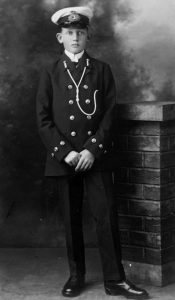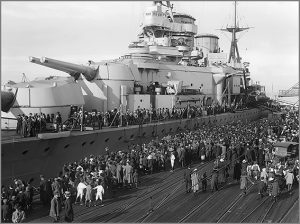- Author
- Editorial Staff
- Subjects
- Biographies and personal histories
- Tags
-
- RAN Ships
- None noted.
- Publication
- March 2018 edition of the Naval Historical Review (all rights reserved)
Three very ordinary looking cartons arrived at our office; within them lay dust covered volumes, the pages of which had not been turned in many a long day. But look further as a tale is told of love, hope and tragedy covering both naval and social history from the First World War to the Great Depression.
From the estate of a past officer, the Naval Historical Society recently received the kind donation of some nautical books for its library. There is nothing unusual about this, but in this instance the officer was a member of the 1915 intake of the Royal Australian Naval College, the first intake after the College had relocated from Osborne House at Corio Bay, Victoria to Jervis Bay, New South Wales. Tragically at a young age the officer died in England in August 1931 over 86 years ago. Who was he and what were the circumstances?
From New Italy to Jervis Bay
Norwood Pursey Morgan was born on 30 September 1901, the only son of Thomas Jasper Morgan and Ada Selina Morgan (nee Pursey). The Purseys were selector/farmers at Bungawalbyn on the Richmond River near Coraki. Thomas Morgan was an ordained Anglican minister from the village of Osweltwisle on the Lancashire moors in north-west England. He was born at his mother’s family home in Preston; his mother’s maiden name was Elizabeth Norwood.
Thomas and Elizabeth Morgan migrated to the then colony of New South Wales in 1881 and went to Tweed Heads where Thomas’s brother was a boat builder. The following year he was appointed as teacher to the nearby Point Danger School. In 1886 he was appointed to the Bungawalbyn School. One of his pupils was Ada Pursey, tongues were set wagging when he married his ex-pupil the pretty young Ada, who was sixteen years his junior.
In 1890 he was appointed as schoolmaster at New Italy1, a small Italian settlement near Woodburn in northern NSW. They lived in a newly built four bedroom house next to the school. When he first arrived Thomas had 30 students but as numbers quickly grew Mrs Morgan helped with teaching until 1896, when pupil numbers reached 70 and an assistant master was appointed.
Their first child Marjorie was born in 1893 and it must have been with great joy when a son, Norwood, was born eight years later; at this time his father was nearly 48 years of age. Thomas was affectionately remembered by the local community as a well-educated man who was friend, interpreter and arbitrator to his largely Italian flock. He managed to change the curriculum to giving lessons in English; previously they had been taught in Italian. From 1903 there were a number of further postings to other schools but eventually the family settled at the larger township of Ballina, near the mouth of the Richmond River, where Thomas was headmaster at the Public School.
Researching another unrelated story we can almost certainly identify some pupils at the school in New Italy. An Italian migrant, Rocco Caminiti, also arrived in New South Wales in 1881 and stated farming in New Italy. When he died in 1907 he left behind a wife, five sons and two daughters. A son, Rocco, became a fisherman and later started a successful fishing trawler fleet under the anglicised name of Cam & Sons. A number of Cam trawlers were commissioned into the RAN as minesweepers during WWII.

As a thirteen year old Norwood (Norie) entered the RAN as a Cadet Midshipman on 31 December 1914. In a highly competitive entrance examination he was one of thirty boys selected. The most famous of his term mates, and son of the soil from the north coast of NSW, was a future Chief of Naval Staff, Vice Admiral Sir Roy Dowling. Another contemporary was Ellis Wackett who became an engineering officer and later transferred to the RAAF, rising to the rank of Air Vice-Marshal. At passing out Norwood was awarded ‘maximum time gained’ and the prizes for mathematics and navigation. He became a Midshipman on 1 January 1919 and was then lent to the Royal Navy for service and training.
The Royal Navy beckons
It must have been a wakeup call, first serving in the battlecruiser HMS Tiger followed by a spell in the destroyer HMS Ursa, finishing off with short courses at the splendidly adorned Royal Naval College at Greenwich and finally the gunnery training establishment HMS Excellent. He did well, at Greenwich obtaining the second highest pass mark for the year and gained first class passes in his Sub Lieutenant’s Examinations. As a result he received a Naval Board prize of £10. Norwood was promoted Sub Lieutenant on 15 January 1921 and awarded his Bridge Watchkeeping Certificate in September of the same year. Promotion to Lieutenant came on 15 February 1922.
Norwood returned to Australia in August 1922 and following leave served in HMA Ships Sydney, Brisbane and Adelaide, in the latter two ships he was posted as Intelligence Officer. He was fortunate to be in Adelaidewhen she accompanied the Royal Navy Special Service Squadron on the return leg of its worldwide cruise; they departed Australia in April and arrived in England in September 1924. From here he joined HMS Vernonfor the Long Torpedo Course and later served as an instructor until December 1926. As he achieved first place on the Long Course and collected another Naval Board prize of £10. Surely a bright future now awaited him.
This was by way of a prestigious appointment as Torpedo Officer to the battlecruiser HMS Renown. The 15-inch battlecruiserRenownhad escaped the ravages of tonnage restriction imposed by the Washington Naval Treaty and was one of the glamour ships of the RN being something of a royal yacht; post-war some secondary armament was removed making way for spacious VIP accommodation, a squash court and cinema – both favourites of the Prince of Wales who had used her previously on royal visits to the Empire and beyond.
Norwood joined her two days before Christmas in 1926 when she was being readied for another royal cruise taking Prince Albert Duke of York and his wife Elizabeth (later King George VI and Queen Elizabeth) to Australia for the opening of the new parliament house in Canberra. Luckily for posterity he kept a diary during this voyage which has now passed to us. She sailed from Portsmouth on 6 January 1927 via the Canary Islands, Jamaica, Panama, Fiji and New Zealand. Arrival in Sydney Harbour on Saturday 26 March was to a tumultuous reception with a million plus crowd. One of Uncle Norie’s favourite tales told to his nephews and nieces was of this time when he danced with a beautiful and charming young Duchess2, who on the Quarterdeck after diner one evening, gave Norie and some other young officers lessons in the steps of the Charleston. After this excitement Norwood left the great ship and came down to earth with a posting to the local destroyer squadron which had been gifted to the RAN in 1920. On 27 April 1927 he joined HMAS Swordsman for Flotilla duties and in January 1928, transferred to the Flotilla Leader HMAS Anzac.In both ships he received a handy Table Allowance of 2/6 per day.
In July 1929 Norwood was next posted for service at HMAS Cerberus and was promoted Lieutenant Commander on 15 February 1930. In May 1930 he was best man at the Melbourne society wedding of Roy Dowling to Miss Jessie Blanch. In July of the same year he boarded SS Oronsay for passage to England for a further posting to HMS Vernon, joining her on 19 August 1930. Here he was placed in charge of the experimental station, conducting technical research into reflecting glass used in searchlights.

A sad ending
On Friday 14 August 1931 Norwood with another RAN officer, Lieutenant James Walton who was serving on exchange in HMS Concord, left Portsmouth and drove towards London for a long carefree weekend. Near Hatfield they were involved in a serious accident, crashing into an oncoming lorry. The injured were promptly taken to the nearby De Havilland Aerodrome for emergency first-aid before an ambulance took them to the nearest hospital at St Albans in Hertfordshire. Lieutenant Commander Morgan died on the way to hospital but Lieutenant Walton and the lorry driver recovered from their injuries.
A week later the remains of Norwood Pursey Morgan were buried with full military honours in the Haslar Royal Naval Cemetery at Portsmouth on Saturday 22 August 1931. The coffin, draped by the Australian National Flag, was surmounted with his sword and cocked hat and a wreath from his parents. The pall-bearers were Lieutenant Commanders Calder, Gower and Burney, Lieutenants Hole, Burrell and Read and Sub Lieutenant Lancaster, all of the RAN. The bearers were six Chief Petty Officers from HMS Vernon. Vernon also provided an escort of two hundred sailors, together with a Petty Officer’s Guard of 24 men and a firing party commanded by an officer with another 24 men. All warships in Portsmouth Harbour solemnly flew their flags at half-mast. Wreaths were sent by the Commonwealth Government and Australian officers serving in England.
Norwood Morgan was struck down in the prime of his life just short of his thirtieth birthday. Mr F.B. Eldridge in his History of the Royal Australian Naval College and summary of students from the 1915 year says that: In him the Navy lost a very brilliant young officer. Sadly his father Thomas, then aged 80, died three years later in April 1934, and his mother Ada died many years later in 1952 at age 82.
Our Gift
As Norwood was unmarried his effects came to his parents and then to his sister Marjorie. The gift received by our Society comes from Mrs Margaret Williams of another selector/farming family of Swan Bay near Bungawalbyn. Margaret’s late husband Henry Walter Williams was Marjorie’s son who inherited his uncle’s memorabilia. Mrs Williams, now living in Coraki and approaching her senior years, is de-cluttering and following her husband’s wishes is returning Norwood’s possessions to its naval home. Both the Pursey and Williams families have been life-long friends and near neighbours and their properties are still owned and operated by their descendents.
The cartons we received contain the usual array of Seamanship Manuals and Nautical Tables but also enclosed is his Midshipman’s Journal, some photograph albums and a small copper plate embossed with the crest of perhaps his most memorable ship, HMS Renown. We shall carefully check this invaluable material and ensure it remains in safe custody for the benefit of future generations.
Notes:
- An adventurer known as the Marquis de Rays established a phantom Pacific paradise ‘La Nouvelle France’ in New Ireland (PNG) resulting in three shiploads of prospective European colonists paying for the privilege and arriving from 1879. The scheme was a disaster, half the colonists died and the settlement was abandoned in 1882. The NSW Government, knowing of their plight, rescued 217 survivors, mainly Italians, most of who were resettled near Woodburn in northern NSW which they called New Italy. See The Phantom Paradiseby Jerry Lattin – NHR September 2013.
- At this time more properly styled Her Royal Highness The Duchess of York.




